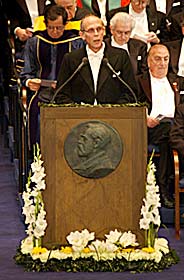Award ceremony speech
Presentation Speech by Professor Sune Svanberg of the Royal Swedish Academy of Sciences, December 10, 2001.
Translation of the Swedish text.

Copyright © Nobel Media AB 2001
Photo: Hans Mehlin
Your Majesties, Your Royal Highnesses, Honoured Nobel Laureates, Ladies and Gentlemen,
Three quarters of a century ago, Bose and Einstein made theoretical predictions that this year’s Nobel Laureates in Physics succeeded in implementing 70 years later in the form of an exciting new state of matter. The so-called Bose-Einstein condensate they achieved has the same relationship to a piece of ordinary matter as a laser beam has to the light from a bulb.
The world consists of interacting particles and waves. In our ordinary perception of reality, we are fairly confident that we can distinguish easily between waves and particles, but in fact they can sometimes switch identities. Light waves may be regarded as a stream of massless particles, also called photons, and particles of matter sometimes have a wavelike nature. Generally speaking, the corresponding wavelength is extremely short, but for atoms that move slowly, it may be observable. Einstein predicted that if a gas is cooled to very low temperatures, all the atoms should gather in the lowest energy state. Matter waves of the individual atoms then merge into a single wave; indeed, they can be said to “sing in unison.” Thousands of atoms behave like one big superatom. This is Bose-Einstein condensation. However, the phenomenon can only occur with a special type of particles called bosons. Electrons are an example of another type of particles. They are not at all “sociable”; they absolutely do not wish to be in the same state and behave in the same way, but instead they arrange themselves in the increasingly complex electron shells of atoms, building up the periodic system of the elements.
To achieve Bose-Einstein condensation, a gas must be cooled to less than one millionth of a degree above absolute zero. The 1997 Nobel Laureates had developed effective laser-based methods for cooling and trapping atomic gases, but the path to Bose-Einstein condensation remained extremely difficult. Carl Wieman pointed toward a successful method: laser cooling of alkali atoms in a so-called magneto-optical atom trap and then continued reduction of speed through evaporative cooling, which is a way of systematically getting rid of the fastest atoms. After extensive efforts by the research team in Colorado, Eric Cornell solved the last remaining problem that prevented condensation. The successful experiments using rubidium atoms were reported in 1995.
Wolfgang Ketterle worked independently of Cornell and Wieman, and 4 months after them he reported large condensates of laser-cooled sodium atoms. Ketterle was able to demonstrate that the condensate actually behaved as a single coherent wave. He did an experiment similar to the one where two stones are thrown simultaneously at a calm water surface and their wave patterns roll into each other, strengthening and weakening each other in a systematic way. This is in greater contrast to what happens when uncoordinated matter, for example two fistfuls of sand, are thrown on the water surface. Ketterle was also able to extract a beam of coherent matter from the condensate, thus achieving the first atom laser. An ordinary laser yields coherent radiation, an atom laser a stream of coherent matter.
When a gas consisting of uncoordinated atoms turns into a Bose-Einstein condensate, it is like when the various instruments of an orchestra with their different tones and timbres, after warming up individually, all join in the same tone.
After the pioneering experiments of this year’s Laureates, condensates have now been achieved by more than twenty additional research teams. Many fascinating applications are conceivable. Precision measurements utilizing slow atoms may offer big surprises: perhaps what we today call natural constants are completely constant. The new control over matter that Bose-Einstein condensation provides may have far-reaching practical applications, for example in lithography and nanotechnology.
Professor Cornell, Professor Ketterle, Professor Wieman.
Your groundbreaking work on Bose-Einstein condensation has opened up a very fruitful area of research and potential applications. On behalf of the Royal Swedish Academy of Sciences, I wish to congratulate you on your great accomplishments. I now ask you to step forward to receive your Nobel Prizes from the hands of His Majesty the King.
Nobel Prizes and laureates
Six prizes were awarded for achievements that have conferred the greatest benefit to humankind. The 14 laureates' work and discoveries range from quantum tunnelling to promoting democratic rights.
See them all presented here.
